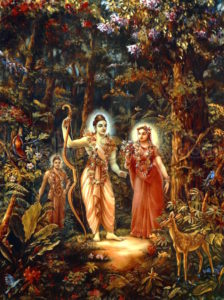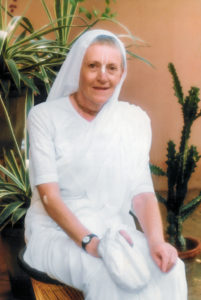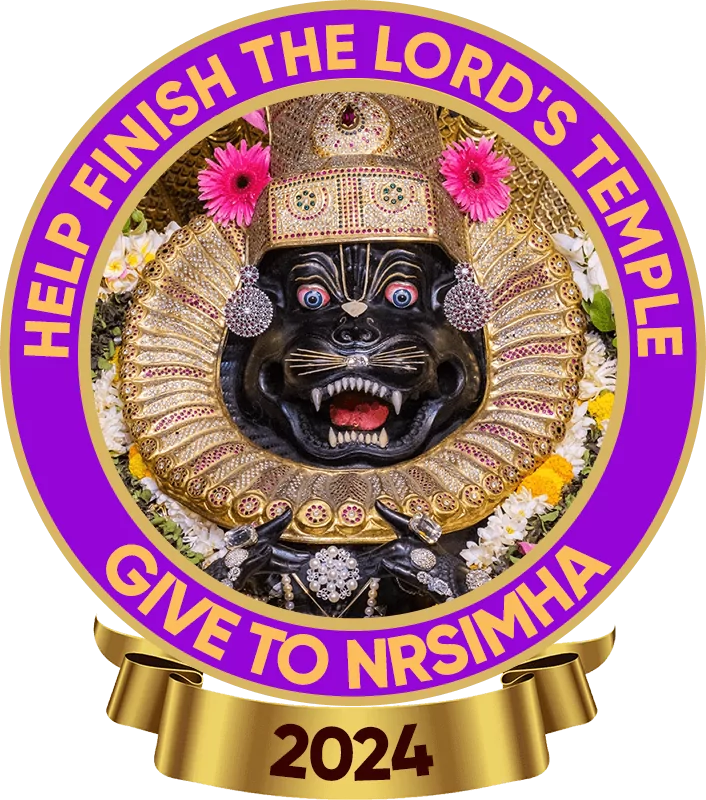 Today is Sita-navami, the appearance day of Srimati Sitadevi, the eternal consort of Lord Ramachandra. She appeared as the daughter of King Janaka, one of the twelve mahajanas, great authorities in Krishna consciousness, and thus one of her names is Janaki. In Valmiki’s Ramayana, Sita is said to have been discovered in a furrow in a ploughed field believed to now be the city of Sitamarhi in the Mithila region of present-day Bihar, and for that reason she is regarded as a daughter of Bhumi Devi (the goddess earth).
Today is Sita-navami, the appearance day of Srimati Sitadevi, the eternal consort of Lord Ramachandra. She appeared as the daughter of King Janaka, one of the twelve mahajanas, great authorities in Krishna consciousness, and thus one of her names is Janaki. In Valmiki’s Ramayana, Sita is said to have been discovered in a furrow in a ploughed field believed to now be the city of Sitamarhi in the Mithila region of present-day Bihar, and for that reason she is regarded as a daughter of Bhumi Devi (the goddess earth).
To begin, we shall read from Sri Caitanya-caritamrta, Madhya-lila, Chapter Nine: “Lord Caitanya’s Travels to the Holy Places.”
TEXT 2
jaya jaya sri-caitanya jaya nityananda
jayadvaita-candra jaya gaura-bhakta-vrnda
TRANSLATION
All glories to Lord Sri Caitanya Mahaprabhu! All glories to Lord Nityananda Prabhu! All glories to Sri Advaita Prabhu! And all glories to all the devotees of Sri Caitanya Mahaprabhu!
TEXT 178
daksina-mathura aila kamakosthi haite
tahan dekha haila eka brahmana-sahite
TRANSLATION
When Sri Caitanya Mahaprabhu arrived at southern Mathura from Kamakosthi, He met a brahmana.
TEXTS 179–193
The brahmana who met Sri Caitanya Mahaprabhu invited the Lord to his home. This brahmana was a great devotee and an authority on Lord Sri Ramacandra. He was always detached from material activities.
After bathing in the river Krtamala, Sri Caitanya Mahaprabhu went to the brahmana’s house to take lunch, but He saw that the food was unprepared because the brahmana had not cooked it.
Seeing this, Sri Caitanya Mahaprabhu said, “My dear sir, please tell Me why you have not cooked. It is already noon.”
The brahmana replied, “My dear Lord, we are living in the forest. For the time being we cannot get all the ingredients for cooking.
“When Laksmana brings all the vegetables, fruits, and roots from the forest, Sita will do the necessary cooking.”
Sri Caitanya Mahaprabhu was very satisfied to hear about the brahmana’s method of worship. Finally the brahmana hastily made arrangements for cooking.
Sri Caitanya Mahaprabhu took His lunch at about three o’clock, but the brahmana, being very sorrowful, fasted.
While the brahmana was fasting, Sri Caitanya Mahaprabhu asked him, “Why are you fasting? Why are you so unhappy? Why are you so worried?”
The brahmana replied, “I have no reason to live. I shall give up my life by entering either fire or water.
“My dear sir, Mother Sita is the mother of the universe and the supreme goddess of fortune. She has been touched by the demon Ravana, and I am troubled upon hearing this news.
“Sir, due to my unhappiness I cannot continue living. Although my body is burning, my life is not leaving.”
Sri Caitanya Mahaprabhu replied, “Please do not think this way any longer. You are a learned pandita. Why don’t you consider the case?”
Sri Caitanya Mahaprabhu continued, “Sitadevi, the dearmost wife of the Supreme Lord Ramacandra, certainly has a spiritual form full of bliss. No one can see her with material eyes, for no materialist has such power.
“To say nothing of touching Mother Sita, a person with material senses cannot even see her. When Ravana kidnapped her, he kidnapped only her material, illusory form.
“As soon as Ravana arrived before Sita, she disappeared. Then just to cheat Ravana she sent an illusory, material form.
TEXT 194
aprakrta vastu nahe prakrta-gocara
veda-puranete ei kahe nirantara
TRANSLATION
“Spiritual substance is never within the jurisdiction of the material conception. This is always the verdict of the Vedas and Puranas.”
PURPORT by Srila Prabhupada
As stated in the Katha Upanisad (2.3.9, 12):
na sandrse tisthati rupam asya
na caksusa pasyati kascanainam
hrda manisa manasabhiklpto
ya etad vidur amrtas te bhavanti
naiva vaca na manasa
praptum sakyo na caksusa
“Spirit is not within the jurisdiction of material eyes, words, or mind.”
Similarly, Srimad-Bhagavatam (10.84.13) states:
yasyatma-buddhih kunape tri-dhatuke
sva-dhih kalatradisu bhauma ijya-dhih
yat-tirtha-buddhih salile na karhicij
janesv abhijnesu sa eva go-kharah
“A human being who identifies his body made of three elements with his self, who considers the by-products of his body to be his kinsmen, who considers the land of his birth worshipable, and who goes to a place of pilgrimage simply to take a bath rather than to meet men of transcendental knowledge there is to be considered like an ass or a cow.”
These are some Vedic statements about spiritual substance. Spiritual substance cannot be seen by the unintelligent, because they do not have the eyes or the mentality to see the spirit soul. Consequently they think that there is no such thing as spirit. But the followers of the Vedic injunctions take their information from Vedic statements, such as the verses from the Katha Upanisad and Srimad-Bhagavatam quoted above.
COMMENT by Giriraj Swami
We know from Srila Prabhupada, from the Bhakti-rasamrta-sindhu:
nama cintamanih krsnas
caitanya-rasa-vigrahah
purnah suddho nitya-mukto
’bhinnatvan nama-naminoh
Namah cintamanih krsnah: the holy name of Krishna is Krishna Himself. Caitanya-rasa-vigrahah: it is the form of rasa, the reservoir of pleasure. It is purna, complete; suddha, pure; and nitya-mukta, always free from material contamination. Why? Because there is no difference between the holy name of Krishna and the possessor of the name, Krishna Himself (abhinnatvan nama-naminoh).
Now, the question arises, “Since the Lord is spiritual and beyond the jurisdiction of material senses, how can one with materially covered senses touch, or chant and hear, the holy name of Krishna?” In the next verse of the Bhakti-rasamrta-sindhu, Srila Rupa Gosvami explains:
atah sri-krsna-namadi
na bhaved grahyam indriyaih
sevonmukhe hi jihvadau
svayam eva sphuraty adah
Atah means “therefore,” as in athatho brahma-jijnasa. Atah: therefore (that is, because the holy name of Krishna is completely spiritual like Krishna) one cannot chant or hear the holy name—touch the holy name—with materially contaminated senses. However, if we engage our senses in the service of the Lord and the Lord becomes pleased with our service, then the Lord will reveal Himself to us.
In other words, although we cannot perceive the Lord with materially contaminated senses, the Lord can reveal Himself to us when He is pleased by our service; He can purify our senses and make Himself visible to us.
When even a sadhaka, a devotee who is practicing devotional service, cannot touch even the holy name of the Lord, how could a demon like Ravana see or touch Mother Sita, who is directly the spiritual energy of the Lord? It is not possible. What Ravana saw and touched was not the original Sita but maya Sita, an illusory representation of the original Sita. Thus Lord Chaitanya was consoling the brahman: “Don’t lament that Mother Sita has been touched by the demon Ravana. The demon Ravana could not even see her, what to speak of touch her. There is no need to lament.”
TEXT 195
visvasa karaha tumi amara vacane
punarapi ku-bhavana na kariha mane
TRANSLATION
Sri Caitanya Mahaprabhu then assured the brahmana, “Have faith in My words and do not burden your mind any longer with this misconception.”
PURPORT
This is the process of spiritual understanding. Acintya khalu ye bhava na tams tarkena yojayet: “We should not try to understand things beyond our material conception by argument and counterargument.” Maha-jano yena gatah sa panthah: “We have to follow in the footsteps of great authorities coming down in the parampara system.” If we approach a bona fide acarya and keep faith in his words, spiritual realization will be easy.
COMMENT
In the material world everyone is acting independently. Actually, people are not independent, but they imagine themselves to be independent. They want to think for themselves, see for themselves, make their own decisions, make their own plans. Even when they come to the subject of God, they keep the same attitude: “I don’t need anyone to tell me about God. I can think for myself; I can decide for myself.” Or they may accept some authority according to their liking. Many people go to various authorities and pick and choose what they like from each, and in the end they find confirmation for whatever they thought or wanted to begin with. That is not the way to understand God. Rather, one must approach a bona fide spiritual master and surrender. Surrender means no wavering to this side or that side. One must remain fixed in submission and obedience to the spiritual master and accept the spiritual master’s instructions without argument.
Of course, the whole process is based on faith, and therefore Lord Chaitanya’s first words are visvasa karaha tumi amara vacane: “Have faith in My words.” If you do, He says, you will be relieved. But if you don’t have faith in His words, you’ll go on suffering and nobody will be able to help you.
visvasa karaha tumi amara vacane
punarapi ku-bhavana na kariha mane
“Have faith in My words and do not burden your mind any longer with this misconception.”
TEXT 196
prabhura vacane viprera ha-ila visvasa
bhojana karila, haila jivanera asa
TRANSLATION
Although the brahmana was fasting, he had faith in the words of Sri Caitanya Mahaprabhu and accepted food. In this way his life was saved.
COMMENT
The brahman was fasting because he thought that Ravana had touched Sita and kidnapped her. He was ready to give up his life, but because he had faith in the words of Lord Chaitanya Mahaprabhu, he gave up his misconception, took prasada, and saved his life.
TEXT 197
tanre asvasiya prabhu karila gamana
krtamalaya snana kari aila durvasana
TRANSLATION
After thus assuring the brahmana, Sri Caitanya Mahaprabhu proceeded further into southern India and finally arrived at Durvasana, where He bathed in the river Krtamala.
TEXT 199
setubandhe asi’ kaila dhanus-tirthe snana
ramesvara dekhi’ tahan karila visrama
TRANSLATION
Sri Caitanya Mahaprabhu then went to Setubandha [Ramesvara], where He took His bath at the place called Dhanus-tirtha. From there He visited the Ramesvara temple and then took rest.
PURPORT
The path from Mandapam through the ocean to the island known as Pambam consists partly of sand and partly of water. The island of Pambam is about seventeen miles long and six miles wide. On this island, four miles north of Pambam Harbor, is Setubandha, where the temple of Ramesvara is located. This is a temple of Lord Siva, and the name Ramesvara indicates that he is a great personality whose worshipable Deity is Lord Rama. Thus the Lord Siva found in the temple of Ramesvara is a great devotee of Lord Ramacandra. It is said, devi-pattanam arabhya gaccheyuh setu-bandhanam: “After visiting the temple of the goddess Durga, one should go to the temple of Ramesvara.”
In this area there are twenty-four different holy places, one of which is Dhanus-tirtha, located about twelve miles southeast of Ramesvara. It is near the last station of the South Indian Railway, a station called Ramnad. It is said that here, on the request of Ravana’s younger brother Vibhisana, Lord Ramacandra destroyed the bridge to Lanka with His bow while returning to His capital. It is also said that one who visits Dhanus-tirtha is liberated from the cycle of birth and death, and that one who bathes there gets all the fruitive results of performing the yajna known as Agnistoma.
COMMENT
It is said that when Lord Rama was on the way to Lanka, He worshipped a deity of Lord Shiva. Some ignorant people say, “Because Lord Rama worshipped Lord Shiva, Lord Shiva is the Supreme and Lord Rama is subordinate to him.” But actually the opposite is true: Lord Shiva himself is a great devotee of Lord Rama. Sometimes, however, the Lord likes to serve His devotees, as in the case of Krishna and Yasoda. Krishna used to obey the dictations of Yasoda, but that doesn’t mean that Yasoda is God. Krishna used to carry the shoes of Nanda Maharaja, but that doesn’t mean that Nanda Maharaja is God. Krishna drove the chariot of Arjuna, but that doesn’t mean that Arjuna is greater than Krishna. Krishna washed the feet of Sudama Vipra, but that doesn’t mean that Sudama is superior to Krishna. The Lord takes pleasure in worshipping His devotees. Lord Ramachandra wanted to glorify His devotee Shiva, and therefore He may have worshipped him.
Other ignorant people say that because Ravana was a devotee of Lord Shiva, Rama approached Lord Shiva to ask his permission before killing Ravana. Once, at Juhu Beach, a disciple mentioned this idea to Srila Prabhupada, and Prabhupada replied that people who say that Lord Rama had Lord Shiva’s permission to kill Ravana want to say that Lord Shiva is a rascal, that he would give permission for someone to kill his devotee: “Oh, yes. He is my devotee, but it’s all right—you can kill him.” Prabhupada said they want to prove that Lord Shiva is a rascal. Rather, he said—and he quoted the shastra—when Rama was in the process of killing Ravana, Mother Parvati asked Lord Shiva, “Ravana is your great devotee, and now he is in trouble. Why don’t you do something to help him?” And Lord Shiva replied, “Lord Rama is the Supreme Personality of Godhead. When He wants to kill Ravana, what can I do?”
TEXT 200
vipra-sabhaya sune tanha kurma-purana
tara madhye aila pativrata-upakhyana
TRANSLATION
There, among the brahmanas, Sri Caitanya Mahaprabhu listened to the Kurma Purana, wherein is mentioned the chaste woman’s narration.
PURPORT
Srila Bhaktisiddhanta Sarasvati Thakura remarks that only two khandas of the Kurma Purana are now available, namely the Purva-khanda and Uttara-khanda. Sometimes it is said that the Kurma Purana contains six thousand verses, but according to Srimad-Bhagavatam the original Kurma Purana contains seventeen thousand verses. It is considered the fifteenth of the eighteen Maha-puranas.
TEXT 201
pativrata-siromani janaka-nandini
jagatera mata sita—ramera grhini
TRANSLATION
Srimati Sitadevi is the mother of the three worlds and the wife of Lord Ramacandra. Among chaste women she is supreme, and she is the daughter of King Janaka.
TEXT 202
ravana dekhiya sita laila agnira sarana
ravana haite agni kaila sitake avarana
TRANSLATION
When Ravana came to kidnap Mother Sita and she saw him, she took shelter of the fire-god, Agni. The fire-god covered the body of Mother Sita, and in this way she was protected from the hands of Ravana.
TEXT 203
‘maya-sita’ ravana nila, sunila akhyane
suni’ mahaprabhu haila anandita mane
TRANSLATION
Upon hearing from the Kurma Purana how Ravana had kidnapped a false form of Mother Sita, Sri Caitanya Mahaprabhu became very satisfied.
TEXT 204
sita lana rakhilena parvatira sthane
‘maya-sita’ diya agni vancila ravane
TRANSLATION
The fire-god, Agni, took away the real Sita and brought her to the place of Parvati, goddess Durga. An illusory form of Mother Sita was then delivered to Ravana, and in this way Ravana was cheated.
TEXT 205
raghunatha asi’ yabe ravane marila
agni-pariksa dite yabe sitare anila
After Ravana was killed by Lord Ramacandra, Sitadevi was brought before the fire and tested.
TEXT 206
tabe maya-sita agni kari antardhana
satya-sita ani’ dila rama-vidyamana
TRANSLATION
When the illusory Sita was brought before the fire by Lord Ramacandra, the fire-god made the illusory form disappear and delivered the real Sita to Lord Ramacandra.
TEXT 207
sunina prabhura anandita haila mana
ramadasa-viprera katha ha-ila smarana
TRANSLATION
When Sri Caitanya Mahaprabhu heard this story, He was very pleased, and He remembered the words of Ramadasa Vipra.
TEXT 208
e-saba siddhanta suni’ prabhura ananda haila
brahmanera sthane magi’ sei patra nila
TRANSLATION
Indeed, when Sri Caitanya Mahaprabhu heard these conclusive statements from the Kurma Purana, He felt great happiness. After asking the brahmanas’ permission, He took possession of the manuscript leaves of the Kurma Purana.
TEXT 209
nutana patra lekhana pustake deoyaila
pratiti lagi’ puratana patra magi’ nila
TRANSLATION
Since the Kurma Purana was very old, the manuscript was also very old. Sri Caitanya Mahaprabhu took possession of the original leaves in order to have direct evidence. The text was copied onto new leaves in order that the Purana be replaced.
TEXT 210
patra lana punah daksina-mathura aila
ramadasa vipre sei patra ani dila
TRANSLATION
Sri Caitanya Mahaprabhu returned to southern Mathura [Madurai] and delivered the original manuscript of the Kurma Purana to Ramadasa Vipra.
TEXTS 211–212
sitayaradhito vahnis
chaya-sitam ajijanat
tam jahara dasa-grivah
sita vahni-puram gata
pariksa-samaye vahnim
chaya-sita vivesa sa
vahnih sitam samaniya
tat-purastad aninayat
TRANSLATION
“When he was petitioned by Mother Sita, the fire-god, Agni, brought forth an illusory form of Sita, and Ravana, who had ten heads, kidnapped the false Sita. The original Sita then went to the abode of the fire-god. When Lord Ramacandra tested the body of Sita, it was the false, illusory Sita that entered the fire. At that time the fire-god brought the original Sita from his abode and delivered her to Lord Ramacandra.”
PURPORT
These two verses are taken from the Kurma Purana.
TEXT 213
patra pana viprera haila anandita mana
prabhura carane dhari’ karaye krandana
TRANSLATION
Ramadasa Vipra was very pleased to receive the original leaf manuscript of the Kurma Purana, and he immediately fell down before the lotus feet of Sri Caitanya Mahaprabhu and began to cry.
TEXTS 214–218
After receiving the manuscript, the brahmana, being very pleased, said, “Sir, You are Lord Ramacandra Himself and have come in the dress of a sannyasi to give me audience.
“My dear Sir, You have delivered me from a very unhappy condition. I request that You take Your lunch at my place. Please accept this invitation.
“Due to my mental distress I could not give You a very nice lunch the other day. Now, by good fortune, You have come again to my home.”
Saying this, the brahmana very happily cooked food, and a first-class dinner was offered to Sri Caitanya Mahaprabhu.
Sri Caitanya Mahaprabhu passed that night in the house of the brahmana. Then, after showing him mercy, the Lord started toward the Tamraparni River in Pandya-desa.
COMMENT
The chastity of Mother Sita is glorified in similar terms in the summary of the pastimes of Lord Ramachandra in the Ninth Canto of Srimad-Bhagavatam. Because Ravana had been cursed by the anger of Mother Sita, his armies were vanquished and ultimately he was killed.
te ’nikapa raghupater abhipatya sarve
dvandvam varutham ibha-patti-rathasva-yodhaih
jaghnur drumair giri-gadesubhir angadadyah
sitabhimarsa-hata-mangala-ravanesan
“Angada and the other commanders of the soldiers of Ramacandra faced the elephants, infantry, horses, and chariots of the enemy and hurled against them big trees, mountain peaks, clubs, and arrows. Thus the soldiers of Lord Ramacandra killed Ravana’s soldiers, who had lost all good fortune because Ravana had been condemned by the anger of Mother Sita.” (SB 9.10.20)
After Ravana had been killed, his wife, Mandodari, praised the power of Mother Sita’s chastity, addressing her husband:
na vai veda maha-bhaga
bhavan kama-vasam gatah
tejo ’nubhavam sitaya
yena nito dasam imam
“O greatly fortunate one, you came under the influence of lusty desires, and therefore you could not understand the influence of Mother Sita. Now, because of her curse, you have been reduced to this state, having been killed by Lord Ramacandra.” (SB 9.10.27) In his purport to this verse, Srila Prabhupada explains that any woman who follows the example of Mother Sita’s chastity and service can attain similar power—and that, in fact, women should follow her ideal example: “Not only was Mother Sita powerful, but any woman who follows in the footsteps of Mother Sita can also become similarly powerful. There are many instances of this in the history of Vedic literature. Whenever we find a description of ideal chaste women, Mother Sita is among them. Mandodari, the wife of Ravana, was also very chaste. Similarly, Draupadi was one of five exalted chaste women. As a man must follow great personalities like Brahma and Narada, a woman must follow the path of such ideal women as Sita, Mandodari, and Draupadi. By staying chaste and faithful to her husband, a woman enriches herself with supernatural power.”
Although Mother Sita was completely pure and chaste, some ignorant citizens criticized Lord Rama for accepting her back after she had been abducted by Ravana, and to preserve His authority as king—for the benefit of the citizens—He was obliged to consign her to the care of the great sage Valmiki Muni.
By her transcendental qualities and devotional service, Sitadevi attracted her husband, Lord Ramachandra, the Personality of Godhead. And after she completed her pastimes on earth, He remained absorbed in thought of her—while perfectly executing His royal duties—until He followed her, to continue their eternal lila in the spiritual world.
munau niksipya tanayau
sita bhartra vivasita
dhyayanti rama-caranau
vivaram pravivesa ha
“Being forsaken by her husband, Sitadevi entrusted her two sons to the care of Valmiki Muni. Then, meditating upon the lotus feet of Lord Ramacandra, she entered into the earth.” (SB 9.11.15)
tac chrutva bhagavan ramo
rundhann api dhiya sucah
smarams tasya gunams tams tan
nasaknod roddhum isvarah
“After hearing the news of Mother Sita’s entering the earth, the Supreme Personality of Godhead was certainly aggrieved. Although He is the Supreme Personality of Godhead, upon remembering the exalted qualities of Mother Sita, He could not check His grief in transcendental love.” (SB 9.11.16) Of course, the Lord’s grief upon hearing the news of Sitadevi’s entering the earth was not material. In the spiritual world there are also feelings of separation, but such feelings are a manifestation of the Lord’s internal pleasure potency (hladini-sakti) and give rise to transcendental bliss—although they resemble the miserable feelings experienced by ordinary men and women who are materially attached to each other.
tata urdhvam brahmacaryam
dharyann ajuhot prabhuh
trayodasabda-sahasram
agnihotram akhanditam
“After Mother Sita entered the earth, Lord Ramacandra observed complete celibacy and performed an uninterrupted Agnihotra-yajna for thirteen thousand years.” (SB 9.11.18)
smaratam hrdi vinyasya
viddham dandaka-kantakaih
sva-pada-pallavam rama
atma-jyotir agat tatah
“After completing the sacrifice, Lord Ramacandra, whose lotus feet were sometimes pierced by thorns when He lived in Dandakaranya, placed those lotus feet in the hearts of those who always think of Him. Then He entered His own abode, the Vaikuntha planet beyond the brahmajyoti.” (SB 9.11.19)
Sri Sri Sita-Rama ki jaya!
There is an important lesson for all of us here, whether we are in a man’s body or a woman’s: Sitadevi is the energy of Lord Rama, the property of Lord Rama, and to take the property of the Lord for one’s sense gratification is demonic. Ravana was a scholar, a devotee of Lord Shiva, and he had many, many good qualifications. However, he had one fault that put him in the category of demons: he wanted to take the Lord’s property and enjoy it for himself. As we have been discussing—and maybe realizing—people in Kali-yuga have two sides: the devotee side and the demon side. The demon side wants to take the property of the Lord and enjoy it, like Ravana. So we must be careful that the demonic side does not become predominant. Otherwise, just as Ravana and his whole dynasty were destroyed, our spiritual life will be destroyed.
What is the difference between material and spiritual? When people challenge us, “You are living in a marble palace, you are using telephones, computers, tape recorders, and automobiles, so you are involved in materialism,” how do we reply? “We are using everything in the service of the Lord. What is used in the service of the Lord is no longer material; it becomes spiritual.” And it is true. The temple is spiritual because it is dedicated to the service of the Lord, and all the paraphernalia used in the Lord’s service is spiritual. So, there is no contamination. However, if we use the paraphernalia meant for the service of the Lord for our own sense gratification, then it is no longer spiritual; it becomes maya. Ravana wanted to take Rama’s Sita, but he couldn’t touch the original Sita. He could get only the maya Sita. Similarly, the Lord’s paraphernalia is spiritual when engaged in the Lord’s service, but if we try to use the same things for our sense gratification, they become maya.
We should not be complacent and assume, “I am a devotee, and everything I do is spiritual. Even if I handle money, it is spiritual because it’s for Krishna.” If it is for Krishna, it is spiritual, laksmi, but if it is used for our sense gratification, it becomes material, maya. So, we must be careful in every situation—in every activity, every transaction—to consider, “Am I doing this for Krishna or for sense gratification?” If an activity is done for Krishna, it becomes spiritual, but if that same activity is done for sense gratification, it becomes material. All the things we have, all the paraphernalia, which are meant for Krishna’s service, become maya if we use them for sense gratification. So, we should be very careful, especially if we take donations from the public, directly or indirectly. Even if we don’t directly take donations, we are using donations for our service, so we should take care that the donations we take from the public are used exclusively in transcendental devotional service and not one cent is used for sense gratification. If we use any of it for sense gratification, we are implicated in a cheating process, because the public think they are giving the money for Krishna’s service but in fact we are using it for sense gratification.
Srila Prabhupada said that if we take money in the name of Krishna’s service and then use it for sense gratification, we become debtors to the people who gave us the money. In other words, we are supposed to be only peons, carrying the money from the donor to the Lord—like Hanuman. He went to liberate Sita from Ravana not to keep her for himself but to deliver her to Lord Rama. We should be like Hanuman: we should liberate Sita from the hands of whomever and deliver her to Rama. We are not meant to touch her. If we do, we’ll have to come back in another life and pay our debt to the people from whom we took the money. These are subtle laws, and Srila Prabhupada was concerned that we should not become victims of our desires for sense gratification. Therefore he explained everything very clearly, so that we can be conscientious and use the Lord’s property only for the Lord’s service. Then we will be like Hanuman, the great devotee who got the mercy of Lord Rama. But if we try to use the Lord’s property for our sense gratification, we become like Ravana and will be destroyed.
On this occasion we pray to Mother Sita to bless us to become pure-hearted servants like Hanuman, Laksmana, and Mother Sita herself—and to save us. Whatever Ravana-like demonic tendencies we have, let them be vanquished by her mercy, by her will, so we may continue in our devotional service without any impediment and ultimately attain pure love (prema), our ultimate goal.
Sri Sri Sita-Rama-Laksmana-Hanuman ki jaya!
Sri Sita-navami ki jaya!
Srila Prabhupada ki jaya!
Nitai-gaura-premanande hari-haribol!
[A talk by Giriraj Swami on Sita-navami, May 9, 1995, Bombay]


























